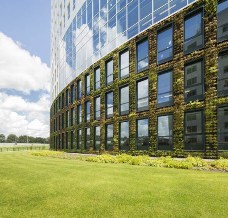I have always had a fondness for climbers. I remember my first house and the gorgeous passionfruit vine that entirely engrossed our fence and garage, producing sweet tropical flowers and delicious purple fruit. I have always found it so aesthetically pleasing to see the natural world lighten and brighten commercial, industrial or residential spaces.
Gardens that develop vertically or are attached to buildings or constructions are known as green walls. This concept has grown and woven itself around the landscaping industry, as more and more homes and businesses enhance their sustainability and promote environmentally friendly aspects in their designs. Planting upwards means you can utilise maximum ground space and this makes them the most practical solution for apartment balconies and restrictive areas. Green walls also provide insulation, creating a thermal barrier which diminishes the need for air conditioning and heating. Green walls also have the ability to act as a natural bio-filter, purifying the air and water through the removal of pollutants. However, I still find the drawcard to green walls being their natural beauty and the sense of wellbeing they promote. The concept of green walls is being adopted in many high-end Sydney bars and restaurants like The Gazebo Wine Garden, The Winery, The Garden Brasserie, Manly Wine Bar and The London Hotel to promote a luxurious, paradisiacal outdoor effect in sheltered areas. Green walls are also used in many grand-scale green constructions to offset energy. In the Netherlands, the 14 storey office headquarters of Eneco utilises interior and exterior green walls to reduce the carbon footprints of all 2,000+ employees.
Green walls are sprouting up all over contemporary architecture, and what a beautiful way to enrich our living and working environments.
|
|
About ODS Contributor
View all posts by this author » |











